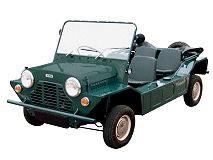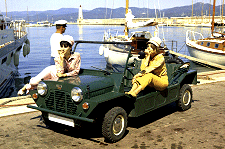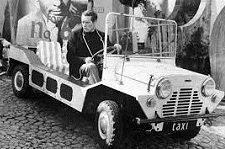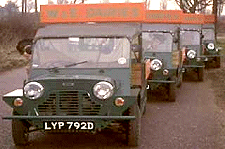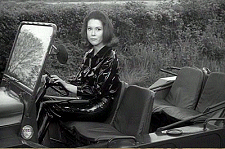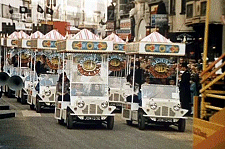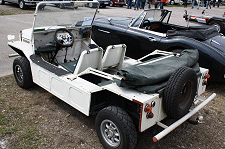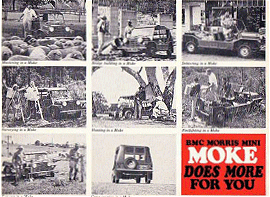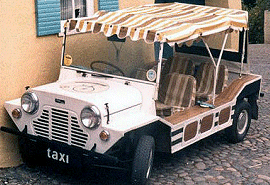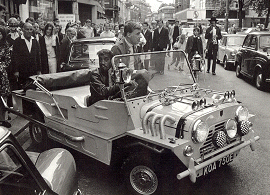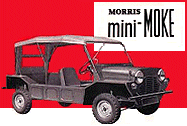 |
The strange name 'Mini Moke' is made up of two parts. The 'Mini'
obviously alludes to its Mini heritage and the alliterative 'Moke'
is a slang term for a donkey, which was probably hoped that it
would be thought of as a kind of 'workhorse'. The American brochures
actually read:
"Own a four-passenger donkey! The Austin Mini Moke is as tough
and versatile as its namesake, but not half so obstinate. The
rugged transverse-mounted BMC engine, combined with front wheel
drive, makes it sure-footed on the roughest terrain. Carrying
a load, caddying around the golf course or coursing over back
roads and beaches, the Austin Mini Moke is the real 'can do' vehicle.
A lot more economical than a donkey, too!"
The Moke was launched on the British market in 1964, first being
built at the Morris factory in Oxford before moving to BMC's Longbridge
plant in Birmingham. Mokes made in Britain were powered by a single
848cc (later 1098cc then 1275cc) engine, detuned to use low-octane
fuel, and the same wheels (10 inch), suspension and gearbox as
a standard Mini. |
It
took nearly 22 seconds to reach 60mph with a top speed of around 65.
Original
'Mark 1' Mokes were fitted with a floor-mounted headlight dip switch
and a single windscreen wiper (which was not necessarily vital as
the windscreen could easily be unbolted and removed if not needed!).
Optional 'extras' included passenger seats, grab handles, heater,
windscreen washer and a removable canvas top, all of which had to
be fitted by the owner. The only colour option was a dark 'Spruce
Green'.
At a price of just £405 it cost less than any other four-wheeled car
on the market. The bizarre reason for this was that it wasn't actually
viewed as a 'car' by Customs & Excise, who classified it as a commercial
vehicle, therefore no purchase tax was payable! Of course, once you'd
purchased the Moke, you could easily 'convert' it into a car by adding
passenger seats and other 'extras'. A conversion company, Crayford
Engineering, produced about 20 Mokes fitted with four seats, striped
upholstery and a fringed Surrey top for export. One remained in the
UK and was used as a taxi in the TV series 'The Prisoner'. A variety
of other Mini-based vehicles were also subject to modification and
conversion inside Crayford's workshops including the Cooper, Wolseley
Hornet and Clubman.
Ultimately, about 90% of the 14,518 Longbridge-made Mokes were exported
to hot countries for use as 'beach buggies', hotel 'tourist taxis'
and even police cars! With the bad winters of 63 and 64 the original
idea of four-wheel drive by way of 'adding an engine' was resurrected.
This initially proved to be a bit of a problem as it was difficult
to synchronise both engines and the dual gear-changes but a compromise
solution was reached by fitting an automatic power unit in the back.
A 'Mark 2' was announced in 1967 to include changes that had been
made to the Mini (the horn and headlight controls now mounted on the
indicator stalk), plus a second windscreen wiper as standard and a
choice of two colours - the original 'Spruce Green' or a new 'Old
English White'. This resurrected Customs interest in the vehicle,
ending its 'tax dodging' by reclassifying it as a car. This raised
the UK price by £78 and severely damaged sales when the marque was
already under threat as the mergers within the British automotive
industry had brought Land Rover into the same stable.
British manufacture ended in October 1968 after 14,518 had been built,
of which all but 1,467 had been exported. A team of Mokes equipped
with roll bars and the Mini Cooper S 1275 cc engine were entered in
autocross grass track competitions in 1968 by the John Player cigarette
company but full 'cult' status was mainly achieved as a result of
its appearance in film and television productions, particularly the
ATV series 'The Prisoner', James Bond movies, notably 'The Man With
The Golden Gun' and 'Pop' movies such as the DC5's 'Catch Us If You
Can'.
Australian Moke production started in 1966 and continued right up
until 1981. To start with they were built exactly like the British
larger 13 inch wheels were fitted after a few months as this made
them a more practical prospect for beach and off-road use with the
slight increase in ground clearance. At the end of UK production in
1968 all the remaining tooling was transferred to the Sydney production
site. A later version called 'The Californian' was made more attractive
by sporting a 1275 cc engine and vastly improved seating. A pick-up
version with a cloth top and drop sides was introduced in 1975. As
in the U.K. a four-wheel drive version also became available, but
this was achieved with a single engine that applied power to the rear
via a transfer box.
In 1981 production (now British Leyland) was transferred to the Portuguese
subsidiary where a further 8,500 'Californians' were produced in the
ten years to 1991. Now called the Rover Group, manufacturing rights
were sold to motorcycle manufacturer Cagiva, who continued production
in Portugal for a further two years, making a further 1,500 Mokes
before deciding to transfer work to Italy, but it was effectively
the end of the line for the Moke. In all, about 50,000 Mokes were
produced. 14,500 were produced in the UK between 1964 and 1968, 26,000
in Australia between 1966 and 1981 and 10,000 in Portugal between
1980 and 1993.
Crayford
Minis Heritage
Motor Centre The
Mini Moke Club

|
|


